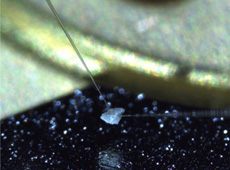Q. What was particularly deserving of attention in the initial results published in the August 26, 2011 edition of the American scientific journal Science?
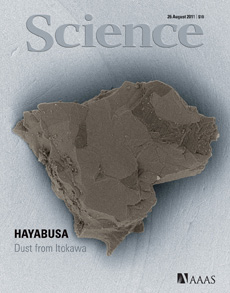
Dust particle from Itokawa on the cover of the American academic journal Science (courtesy: Science)
Proving that asteroids are the parent bodies of meteorites is a major development, but I think that all of the research published in Science is worthy of attention. Personally, I’m interested in the inner structure of asteroids, so I’m curious about analysis of what kinds of energy and heat the minerals inside Itokawa received in the past, and how they were affected.
At most, the objective of the initial analysis is to provide principal information on dust particles for use in future research. If you tell people, “If you use this sample, you might be able to learn this and that,” then everyone will want to study it, right? Only a very small portion of the results were published in Science. The initial analysis is still ongoing. I think we’ll see many more new results from here on out, so I’m very much looking forward to seeing what we’ll find out next.
Q. Have there been any new discoveries in this project that overturn the conventional wisdom?
Well for example, Itokawa originally had a diameter of 20 kilometers, but due to impacts and other processes, it has shrunk to its present 500 meters. Over the course of a million years, countless pieces, many of them dozens of centimeters long, broke off from Itokawa. This sort of gradual change on the surface of an asteroid is not something we could have inferred from studying meteorites. We also never imagined that each of the dust particles brought back would be different. The returned sample contains dust particles that have experienced varying levels of thermal metamorphism and space weathering. There is just so much variety to these particles, which may have broken off of rocks, coalesced from small objects and hardened, or broken off from rocks on other planets. In fact, this can be understood better by actually taking a look rather than relying on words alone. We learned that much more happened on Itokawa than we thought.
Meanwhile, the initial analysis has demonstrated that there are even more things that we don’t understand. Itokawa’s dust particles have the same composition as typical chondrite meteorites, but their structure is different, so a question for us is how to describe the relationship between asteroids and meteorites. We established that meteorites are fragments of asteroids, but we don’t know how they became meteorites. I think that another lesson from the initial analysis is that these processes do not just occur on asteroids out of the blue, and that there is still much more for us to research.
Q. Other than what was published in Science, what sort of initial analysis is happening?
For example, analytical research is being performed on topics such as the presence of organic matter, including carbon, as well as amino acids, which are the building blocks of life. Analysis is also underway to investigate micro-impacts on the granules’ surface layers and whether there are any traces recording accompanying phenomena.
Q. What kind of work is being done with the curation facility?
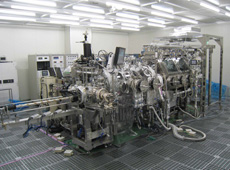
Curation facility
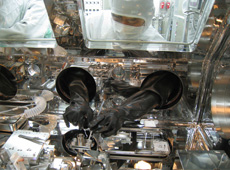
Working with gloves inside the clean chamber
We’ve been using the curation facility to unseal the sample-storage container from the returned capsule, to recover and measure the size of the sample particles, simple component analysis with electron microscopes, cataloguing, storage, and allocation to researchers. Each and every particle is assigned a control number and classified according to size and mineral type. We also record where the sample particles came from and their history. After classification, the particles are stored.
The sample particles are up to 0.2 to 0.3 mm in diameter, but most are very small, 0.01 mm or less. To retrieve them one at a time, we use special devices called micromanipulators, with electrostatic control that grabs and removes the dust particles with static electricity. There are two kinds of micromanipulators: one handles samples with a diameter of 0.01 mm or more, which are visible with an optical microscope, while the other handles samples with a smaller diameter, which we can only observe with an electron microscope.
We control the micromanipulators manually with gloves installed in a clean chamber, but we have to pick up the particles while looking through a microscope, since they are invisible to the naked eye. Because the work is very precise and delicate, it takes one day, on average, to retrieve a single particle and put it in storage. So far we have catalogued 200 Itokawa dust particles (at Nov. 2011), a number that is still continuing to grow.
The particles are kept in a sealed, high-purity nitrogen environment called a clean chamber, which is installed inside a clean room, to keep out contaminants in the air such as oxygen, which would oxidize them, or moisture, which would change the water quality. The sample brought to us by HAYABUSA is something mankind would never have obtained otherwise. Even if we send another probe to Itokawa, the new sample would be collected from a different spot. That’s why we absolutely cannot allow our sample to be contaminated, and we want to retrieve as many particles as we can, even if we only get a few.
Q. You were in charge of developing the curation facility. What sort of difficulties did you encounter?
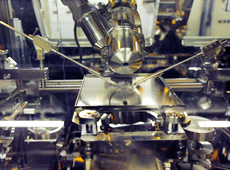
Micromanipulators installed inside the clean chamber
The JAXA curation facility is unlike anything else in the world. These Japanese-made tools can handle extraterrestrial particles in Earth’s environment without contamination or loss. It is also far more compact than the curation facility NASA used to handle moon samples. That facility weighed hundreds of kilograms. Our facility has been customized to process infinitesimal, microscopic samples cleanly, without contaminating them. There’s never been anything like this in the world, so when we were determining the specifications we solicited a wide range of opinions from specialists around the world. And even though we got a lot of useful advice, we were unable to satisfy all the requests due to budget and time constraints, so it was very difficult to choose which ones to adopt.
The curation facility took three years to build, starting in 2005. In 2008, we conducted capability testing; in 2009, we practiced; and when HAYABUSA finally returned we installed the micromanipulators. At first we hadn’t thought of installing these tools, but we figured that, given the conditions under which HAYABUSA collected the sample, it would probably be extremely small, so we decided that the micromanipulators would be needed after all. These tools have special oil-free specifications, designed to move smoothly without using lubricants so as to not contaminate the clean chamber’s high-purity nitrogen environment. It was challenging at first to make these sorts of devices, but with the help of manufacturers from other countries we were able to finish them within about six months of the decision to install them. I think it would have been extremely difficult to retrieve the Itokawa dust particles without the micromanipulators.
Q. How long will sample retrieval continue and what plans do you have to allocate samples to researchers?

Electron microscope photo of the end of the spatula-shaped tool that touched part of the sample storage container
![]()
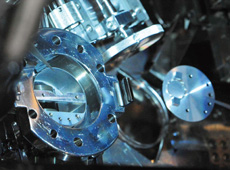
Sample Catcher Room B
After we opened the storage container, our first step was to lightly touch one surface area with a spatula-shaped tool, and then to check the tool’s flat surface with an electron microscope. We identified about 3,300 particles. About 1,800 of them turned out to be man-made – evaporated pure aluminum fragments on the inside wall of the container – while the remaining 1,500 or so particles were from Itokawa. Most of them have a diameter of less than 0.01 mm, though, so we can only see them with an electron microscope. That makes handling these particles a tough task, so we had to think about how best to distribute samples to researchers. We decided to store the smaller particles until we figured that out, while giving priority to retrieving larger pieces that are visible with an optical microscope.
We removed the lid of the sample-storage container, replaced it with quartz glass, flipped the container over and tapped it. That’s how we found particles that were large enough to be observed with an optical microscope. These were the samples we distributed to the initial analysis teams from January through November of 2011.
Then, in December 2011, we made samples available to NASA, who helped us throughout the mission and after HAYABUSA’s return. And in 2012 we plan to start inviting international collaborators to help with the research. Since the sample retrieval takes time, we’re going to start distributing the particles once we’ve gathered a certain amount, rather than waiting until we’ve collected all of them. That means we’ll invite international collaborators more than just once. Furthermore, after they are analyzed, the samples will be returned to JAXA. We’ll keep a record of what sort of analysis was performed, and put the particles in storage, so that later they can be analyzed further. The sample we got from Itokawa is very valuable and irreplaceable, so I want to make very effective use of it so that we can all work together to maximize the results.
Q. What sort of research do you personally want to do on the Itokawa dust particles?
I want to investigate what is recorded in the Itokawa sample: the history of the energy that has affected the asteroid and the forces that have pulled on it. I want to unlock physical information on how strong the forces acting inside Itokawa were, how fast it was pulled, and how hot it became. Then I want to shed more light on the relationship between asteroids and meteorites by comparing meteorites with what happened on Itokawa. I’d also like to deduce what will happen on the asteroid in the future, and how moons and planets will evolve in the future.

